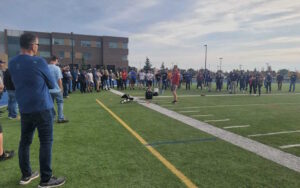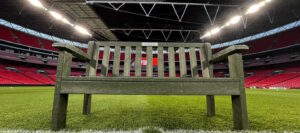GrassMaster history
The first ever full-size GrassMaster field was installed at RKVV Wilhelmina in Den Bosch in the Netherlands, and clubs like Huddersfield, West Ham United, Feyenoord FC, Real Madrid, AS Monaco, Nantes FC and Bayer Leverkusen followed in the years between 1996 and 2004. However, it was the use of the surface at the 2004 Athens Olympics and the EURO 2004 in Portugal that made GrassMaster shoot to prominence. During the 2005/2006 season, many clubs in the English Premier League played on a GrassMaster surface, with Wembley Stadium following in 2010. GrassMaster saved the day for the Mbombela and Polokwane Stadiums in 2010 when both FIFA World Cup venues had their field reinforced shortly before the start of the 2010 World Cup tournament.GrassMaster concept
A GrassMaster pitch has approximately 20 million polypropylene fibres of 20 cm length injected 18 cm deep into the soil in a 2×2 cm grid. The final result will be a surface made up of 3% synthetic turf. The synthetic turf fibres are slightly shorter than the natural grass and will make the surface look green, even when all the grass is gone. It also gives stability to the soil and prevents sods being taken out when players slide over the surface.GrassMaster construction
GrassMaster requires a very sandy soil without soil life or organic matter, similar to those used for installing synthetic turf. The yarn can be injected before or after seeding of the grass or onto the grass sods. The grass roots will intertwine with the fibres. The sandy nature of the soil and the contribution the synthetic turf fibres make in flushing water down along the fibres is why some people complain that the surface quickly dries out. Grass clippings always have to be removed from the grass, as this stimulates soil life as well as the presence of felt in between the grass blades. Felt will push the synthetic turf fibres down, which will affect the performance of the GrassMaster surface.GrassMaster installation
The surface is installed by a machine that injects the fibre into the soil. The machine has evolved over the years. The first machine used for installing a GrassMaster surface was a 2nd generation machine. It was diesel powered and had hydraulics. It weighed approx. 12 tonnes, had a speed of 15m2/hour and was steered manually. The machine was succeeded by the GrassMaster Gen-S. This machine is electrically powered and uses hydraulics to inject the yarn. It weighs 7.5 tonnes, has a speed of 20m2/hour and uses laser to guide the injection process. The latest generation machine is the Gen. 5. This machine is renowned for its silence, weighs 4.5 tonnes, has a speed of 25m2/hour, uses laser, is electrically driven, and, most importantly, no longer uses hydraulics.How much does a GrassMaster cost?
In 2022, GrassMaster charged approx. EUR 40/m2Articles on Hybrid systems

FWC pitches update
A FIFA delegation has visited the University of Tennessee (UT) in Knoxville to inspect the turf research & development (R&D) facility and meet with the

STC dissolves partnership agreement
Members of the Western Canada Turfgrass Association (WCTA) have been informed that Sports Turf Canada (STC) has voted to dissolve the decade plus long partnership agreement.

Wembley Stadium first to return reclaimed hybrid turf
Where the recycling of full-synthetic turf pitches into either new turf or other products has become the norm, Wembley Stadium is the first to have

Irish and Polish incentives to boost infrastructure
Authorities in both Ireland and Poland have released the details of incentives that can help clubs, schools and municipalities to improve their sports infrastructure. The

Another hybrid turf brand enters the US market
With the debate raging about what surface will be used by the NFL, and preparations for the FIFA World Cup starting to take shape, another

The ins and outs of hybrid turf fields
Erwin Beltman was the head groundsman for stadium De Kuip in the Netherlands between 2013 and 2022. In that period, the field was voted the

Amsterdam to investigate hybrid field from biodegradable fibres
The municipality of Amsterdam, Senbis Polymer Innovations, GrassMax and Fitco Grass will jointly investigate whether biodegradable synthetic yarn fibres can be used to reinforce a

More competitions likely to ban synthetic turf
Or login when you are subscribed already Username or Email Address Password Remember Me Register|Lost your password?
What is essential for hybrid turf to succeed?
Question Answer Question Whatis essential for hybrid turf to succeed? Answer There are several critical aspects to a hybrid turf surface. Two that stand out

NFL launches crowd-sourced challenge to improve fields
Or login when you are subscribed already Username or Email Address Password Remember Me Register|Lost your password?

Eddy van Endert: ‘I live in a golden cage’
If the football authorities ever decide to organize a World Cup for grounds teams, it is very likely that you will find the grounds team

Pledge to keep fields clean
An environmental group in Pontardawe (Wales) has launched an initiative to keep sporting grounds and facilities clear of rubbish. The Green Pitch Pledge is a


